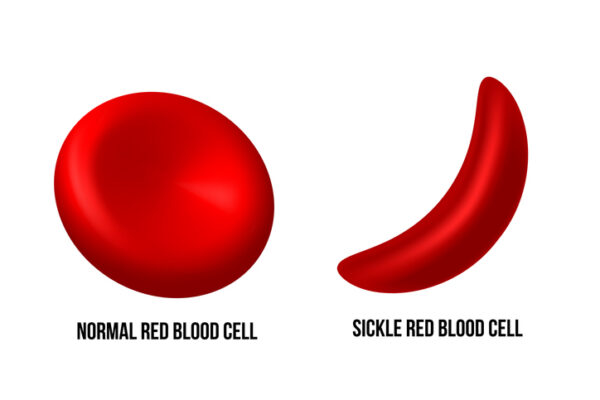Sickle cell disease is an inherited disorder of the red blood cells. It can cause anemia, episodes of severe pain and other symptoms. Here’s what you should know about sickle cell disease.
What is sickle cell disease?
Sickle cell disease affects the red blood cells in your body. Healthy red blood cells are round, flexible and smooth. This allows them to easily flow through your blood vessels, delivering oxygen-rich blood throughout your body. 
With sickle cell disease, the hemoglobin, the portion of the red blood cell that carries oxygen, doesn’t carry oxygen as well as someone without the disease. This causes the hemoglobin to become stiff and clump together, which makes the red blood cell curve, or sickle, in the shape of a banana.
What causes sickle cell disease?
Sickle cell disease is inherited, which means it’s not contagious. It occurs from a mutation in the gene that tells the body to make hemoglobin. For a child to have sickle cell disease, they have to receive a copy of the sickle cell gene from mom and dad. If a child receives only one copy of the gene, their blood may contain normal blood cells and sickled blood cells, and they won’t experience symptoms.
How do sickle cells affect the body?
Sickled red blood cells affect the body in many ways, often leading to the symptoms of sickle cell disease. Here’s what can happen to your body if have sickle cell disease:
- Because sickled blood cells are stiffer and stickier than healthy red blood cells, they can’t move as freely through your blood vessels.
- The stiffness and stickiness of sickled blood cells can also cause them to clump together, blocking the flow of oxygenated blood to your organs.
- Sickled red blood cells break down more easily than healthy red blood cells, which can cause symptoms of anemia.
What are the symptoms of sickle cell disease?
The symptoms of sickle cell disease usually appear by nine to 12 months of age. You may notice your baby has jaundice, or a yellowing of the skin and eyes, is fussier than normal or has swollen hands and feet. Other symptoms can vary over time and may even change. They can include:
Anemia: Sickled red blood cells break apart easier than healthy cells, which can affect the flow of oxygen to your organs. Healthy red blood cells usually take 120 days to break down, but sickled red blood cells break down in 10 to 20 days. As a result, you or your child could feel extremely fatigued.
Episodes of extreme pain: Known as a pain crisis, episodes of extreme pain are one of the telltale signs of sickle cell disease. Pain occurs because the sickled red blood cells clump together and block the flow of oxygen to organs or areas of the body. The pain can vary in intensity and last from a few hours to a few days.
If your child has a severe pain crisis, they may need a hospital stay.
Delayed growth: If your child has sickle cell disease, you may notice a delay in their growth or the onset of puberty. This is because the sickled cells in your child’s body don’t provide the adequate oxygen need for growth.
Vision issues: You also might find that your child has vision problems if they have sickle cell disease. Vision problems can develop due to the accumulation of sickle cells in the blood vessels that supply the eyes.
Who is most at risk for sickle cell disease?
In the US, sickle cell disease most commonly seen in people of African, Middle Eastern and Mediterranean descent.
How is sickle cell disease treated?
Sickle cell disease is treated through medications that:
- Prevent the red blood cells from sticking together
- Treat pain crises
- Reduce the likelihood of complications from the disease
Blood transfusions may also help relieve symptoms and prevent complications. A bone marrow transplant is the only cure for sickle cell disease, according to the National Institutes of Health.
The CDC suggests these lifestyle adjustments to help sickle cell disease patients feel better:
- Drink plenty of water
- Avoid getting too hot or cold
- Avoid exposure to high altitude
- Wash your hands often, prepare food safely and get necessary vaccines to prevent severe infections.
If you’re concerned about your child’s symptoms, talk with their pediatrician. If your child needs a pediatrician, schedule an appointment with an Akron Children’s provider.










